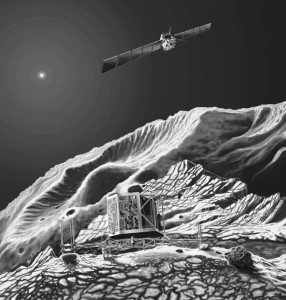Although I’ve bounced about between industry and academia, and various topics within, my interests seem to centre on the surfaces of Solar System bodies, their physical properties and interactions. You can find out more about a few of these topics here, and more details in my publication list, posters, movies or blog. You can even read my thesis, if you’re really bored 😉
[one_half]
Rosetta and MIDAS

The European Space Agency‘s Rosetta spacecraft is a unique mission to rendezvous with, orbit and land on a comet. Reaching the comet far enough from the Sun that it is still inactive, it gives us the chance to study the whole cycle of an active comet, and hopefully gives new insights into the early stages of the formation of our own Solar System.
[/one_half][one_half_last]
Low gravity regoliths

Regolith is a term used to describe the loose surface material found on most terrestrial planets. Unlike on Earth, regolith on the Moon, Mercury and asteroids is formed by impacts and irradiation, not wind, ice and worms! It also behaves very differently from Earth soil under low gravity, providing unique science, and an engineering nightmare!
[/one_half_last]
[one_half]
Space Weathering

Roughly defined, space weathering is the interaction of meteorite impacts, solar wind sputtering and other agents on the surface of an airless body, and the resulting changes. Although this process makes tiny changes to the surface of soil grains, the accumulation of these changes makes remotely determining surface composition challenging!
[/one_half][one_half_last]
Cometary dust

Comets are believed to be reservoirs of almost pristine material. But when they near the Sun they become very dynamic objects in which gases sublimated due to solar heating stream out of the nucleus, dragging dust particles along the way. It is these dust particles that reflect and scatter light to produce the amazing comae that we see from Earth.
[/one_half_last]